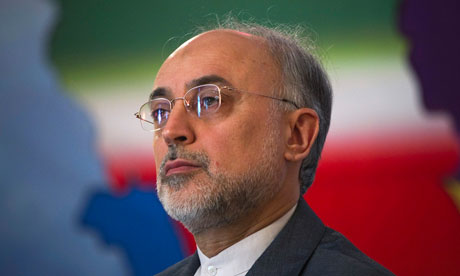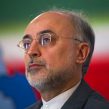
Iranian Soft Power in Tajikistan: Beyond Cultural and Economic Ties
Publication: Eurasia Daily Monitor Volume: 9 Issue: 52
By:

On March 9, Iranian Foreign Minister Ali Akbar Salehi wrapped up a three day visit to Tajikistan to discuss developments in joint economic projects including the construction of the Cangtuda-2 dam, Istiqlol tunnel and the beginning of a new Aini hydroelectric station in the Zarafshan River (ozodi.org, March 6). This visit comes on the heels of a February 24 announcement of Iran’s intention to build a 100 hectare industrial park near the capital, Dushanbe, which could significantly increase bilateral trade. Last year, the trade volume between Iran and Tajikistan reached $200 million, representing a 50 percent increase from the previous year (BBC Tajiki, February, 25). (For further background on Iranian-Tajik economic ties see EDM, April 5, 2011.)
Salahi’s trip anticipates a more high profile visit by President Mahmoud Ahmadinejad planned later this March on the occasion of Nowruz, the Persian New Year. While a shared common language, culture and history are often cited as reasons for close Iranian and Tajik ties, some experts cite Tajikistan’s secular government and predominantly Sunni population as a decisive limiting factor in Iran’s bid to increase its influence. Many have even come to the conclusion that the Iranian projection of soft power in Tajikistan is merely intended to serve Tehran’s strategic rather than ideological aims.
However, in spite of the challenges, Iran does attempt to project religious/ideological soft power that goes beyond the more obvious economic and cultural cooperation. Various organs of the Iranian government maintain Tajik language media outlets (printed in the Cyrillic alphabet) such as Radio Tajiki or “The Voice of Khorasan.” Launched on December 23, 1992 and under the indirect control of the Iranian Revolutionary Guard, Radio Tajiki, in addition to providing regional world news and social and political commentary, is also tasked with the mission of: “Familiarizing audiences with Islam and the message of the Islamic Revolution and the propagation of the pure ideas of the founder of the system of the Islamic Republic of Iran, Imam Khomeini (peace be upon him)” (https://tajik.irib.ir/tajiki/16-Таърихча.html).
Likewise, the media outlet of the late Lebanese Ayatollah Muhammad Hussein Fadl-Allāh, considered to be the spiritual mentor of Hezbollah, also maintains a special Tajik language website “bayynattj.com” with original content not accessible on its main website “bayynat.org,” which is printed in English, French, Arabic and Persian. The Tajik website has translations of the works of Ayatollah Fadl-Allāh and other prominent Shia clerics as well as content provided by Tajik thinkers such as Saidyunisi Istaravshani based at the Al-Mustafa University in Iran. Istaravshani also operates another website, “kemyaesaadat.com,” and has been accused by Sunni Tajiks of being a secret Shia convert engaged in proselytizing under the cover of “taqiyya” – the Islamic doctrine of dissimulation, which allows Muslims (usually Shia living under Sunni persecution) to deny sectarian affiliation.
Istaravshani’s lectures and writings seem to epitomize the Iranian approach of “strategic ecumenism,” which usually downplays sectarian differences in favor of unity, cooperation and dialogue. This pragmatic approach is institutionalized in several Iranian government organizations including The World Forum for Proximity of Islamic Schools of Thought, whose expressed aim is to: “Endeavor to coordinate and establish a joint front to confront the propaganda plots and cultural onslaught of [the] enemies of Islam.” (https://www.taqrib.info/english/). In the 2009, the Secretary General of the World Forum, Ayatollah Mohammad-Ali Taskhiri, visited Tajikistan for a conference on Islamic cooperation and emphasized the need for unity and the “rational resolution of theological disputes” (Hawza.org). Like Radio Tajiki, the World Forum also has a Tajik language website with original content for Tajik audiences (https://www.taqrib.info/tajik/). Pursuant to the preservation of unity, Iranian clerics usually refrain from criticizing mainstream Sunni schools of jurisprudence (such as the Hanafi School practiced in Tajikistan). However, they do engage in polemic against Takfiri currents in Sunni Islam such as Wahhabism or Salafism whose fundamentalist interpretation considers Shia to be apostates. Saidyunisi Istaravshani’s website has an entire section devoted to articles and video clips arguing against Wahhabism.
The Iranian government has also been a long-time supporter of Tajikistan’s main opposition party, the Islamic Renaissance Party (IRP). Muhammadjon Nuri, son of the late founder of the party Said Abdullo Nuri, is an Iranian educated cleric, although in 2006 he was passed over for appointment to leadership in favor of the current party leader Muhiddin Kabiri. Additionally, Influential Tajik clerics Hoji Akbar Turajonzoda and his brother Eshon Nouriddinjon have aroused suspicions of “secret Shism.” In December of 2011, the head of Tajikistan’s Council of the Ulema, Saidmukarram Abduqodirzoda filed a formal complaint against the Turajonzoda brothers for allegedly trying to create sectarian strife by commemorating the Shia festival of Ashura (for more background see EDM, January 12).
Another more proactive means for spreading the Iranian worldview is the Imam Khomeini Relief Committee, whose operation is directly controlled by the office of the Supreme Leader. The Committee’s work focuses on countries with either large Shia communities who also receive substantial economic and military assistance (Lebanon, Iraq and Syria) or countries in Central Asia that comprise part what it sometimes referred to in imperial Persian discourse as “Greater Khorasan.” While ostensibly a humanitarian organization, the Committee is widely recognized as one of the primary means of exporting Iranian soft power. According to statistics on its website, as of 2009 the Committee has 43 facilities in the country including a main office in the capital Dushanbe, six regional offices in Nurabad, Qurgan Teppa, Vahdat, Badakhshan, Kulob, and Khujand, 20 distribution centers, 13 “workshop units,” a cultural center and a clinic (emdad.ir).
Additionally, it is estimated that hundreds of Tajik students have gone to Iran for theological training, a trend, which has caused the Tajik government concern. In 2010, Emomali Rahmon ordered the return for 137 Tajik students studying at madrassas in Iran fearing their radicalization (rferl.org, March 10). Actions such as these have engendered criticism from Iran. Grand Ayatollah Saafi Gulpaygani has sharply criticized the Tajik government for its “anti-Muslim measures” including the banning of the hijab and the prohibition on children under the age of 18 from attending Friday sermons at mosques. In a speech delivered on January 25, 2012, he warned the Tajik government, “You should know that the approach you have adopted will end in failure. You must formally apologize to not only the brave and proud people of Tajikistan, but to all the Muslims of the world. It is expected that all Muslim countries and the Organization of Islamic Cooperation condemn this anti-Islamic program and will send a warning to the rulers of Tajikistan” (mehrnews.com, January 25).
While President Emomali Rahmon welcomes both Iranian investment and aid and uses appeals to a shared Persian identity as a means of offsetting Russian influence, his fear of Islamic radicalization limits his degree of engagement with Iran. While its apparently ecumenical approach to proselytizing is on the surface perceived as less dangerous than that of the extremist Sunni varieties being imported from Afghanistan, Pakistan and Saudi Arabia, the trend of Iranian Twelver Shism in Tajikistan is seen as destabilizing for its capacity to create new sectarian divisions in a country where there are already too many ethnic and regional fault lines. At the same time, aside from Iran’s strategic interests in “Greater Khorasan,” Tajikistan’s common cultural ties, unique Muslim population (who are both more observant than those of other former-Soviet Central Asian republics, but not yet as deeply entrenched in Sunni orthodoxy as the those in Afghanistan) and the existence of a secular, illegitimate government provide elements of the Iranian regime with a tempting target for spreading its revolutionary ideology; albeit through more subtle and incremental means then they employ elsewhere.




